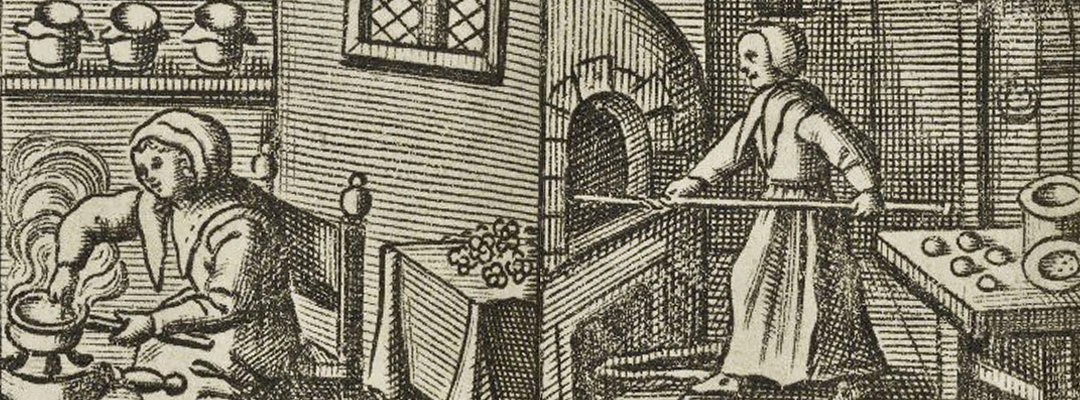The Countess of Kent and a Cookbook
How one of the earliest celebrity cookbooks, attributed to Elizabeth Grey of Wrest Park, Bedfordshire, includes cures for pox, plague and pestilence as well as recipes for culinary treats.

LITERARY PATRON
Elizabeth Grey, née Talbot (born in 1582), was a great heiress, an attendant to Queen Henrietta Maria, and the wife of Henry Grey, Earl of Kent. She was also renowned for her patronage of talented individuals. At their main home, Wrest Park, she played host to a circle that included the scholars John Selden and Robert Cotton, the poet Thomas Carew, and later the poet Samuel Butler and the miniaturist Samuel Cooper.
‘GENTLEWOMAN’S DELIGHT’
But the Countess of Kent is probably best known for an enormously popular collection of household recipes bearing her name. The catchily titled A Choice Manuall, or Rare and Select Secrets in Physick and Chyrurgery: Collected, and Practised by the Right Honourable, the Countesse of Kent, Late Deceased was first published in 1653, two years after her death.
This collection was in fact compiled by the book’s editor, William Jarvis, a ‘professor of physick’, although Jarvis claimed that all the medical recipes in the book were ‘collected and practised’ by the countess. It is split into two parts. The first is medicinal, while the second, ‘A True Gentlewoman’s Delight’, is dedicated to luxurious culinary fare.
A typical recipe from the latter, attributed to Alathea, Countess of Arundel (Elizabeth Grey’s sister), is for a rich, dense bread known as manchet. Manchet was apparently a favourite at the court of Henry VIII, and remained popular for centuries after.
MOUNTAINS OF MANCHET
The recipe for Lady Arundel’s Manchet is remarkably concise:
Take a bushel of fine Wheat flower, twenty Eggs, three pound of fresh butter, then take as much Salt and Barme after the ordinary Manchet, temper it together with new Milk pretty hot, then let it lie the space of half an hour to rise, so you may work it up into bread, and bake it, let not your oven be too hot.
‘Barme’, by the way, was a brewer’s yeast carefully skimmed off the top of fermenting ale, after its second week in the vat. Its delicate flavour was preferred to the tanginess of a sourdough starter.
In comparison with other early manchet recipes, Lady Arundel’s is a masterpiece of precision. A recipe from The Good Huswifes Handmaide, written by Thomas Dawson in 1594, relies instead upon a sequence of strikingly ambiguous measurements:
Put in that water as much leaven as a crab, or a pretie big apple, and as much white salt as will into an Egshell…
A note of caution, however: if you are tempted to try the recipe out at home, please note that Lady Arundel was evidently used to making veritable mountains of manchet at a time – probably enough for an entire aristocratic household. So it might be wise to reduce the quantities to a tenth or even a fifteenth of what she suggests.
THE COUNTESS OF KENT’S POWDER
But the dangers of cooking too huge a batch of bread pale next to the hazardous-sounding medicinal recipes in A Choice Manuall.
One of the most popular (and this was a work that stayed in print until 1728, when the 22nd edition was published) was for a ‘cure-all’ powder, ‘good against all malignant and pestilent Diseases, French Pox, Small Pox, Measles, Plague, Pestilence, malignant or scarlet Fevers, [and] good against Melancholy, dejection of Spirits’:
Take the Magistery [essence] of Pearles, of Crabs eyes prepared, of white Amber prepared, Hartshorn, Magistery of white Corral, of Lapis contra Parvam of each a like quantity, to these pouders infused put of the black tips of the great clawes of Crabs, to the full weight of all the rest, beat these all into very fine pouder, and searce [sieve] them through a fine Lawn Searce, to every ounce of this pouder adde a drachm of true Oriental Bezar …
An explanation of each of these ingredients – all chosen for their supposed curative powers – would require an essay in itself. ‘Crabs eyes’, for example, were small stones composed mostly of lime found in the stomachs of crayfish, which were powdered for medicinal use.
Such ‘cure-alls’ were immensely popular at the time, and ‘The Countess of Kent’s Powder’ received consistently good reviews in comparison to its rivals. Indeed, the 17th-century diplomat Sir William Temple declared that ‘Of all Cordialls, I esteem my Lady Kent’s Powder the best, the most innocent, and the most universal’.
It, and the collection as a whole, must surely be among the earliest examples of recipes and remedies trading on a celebrity name.
By Sam Kinchin-Smith